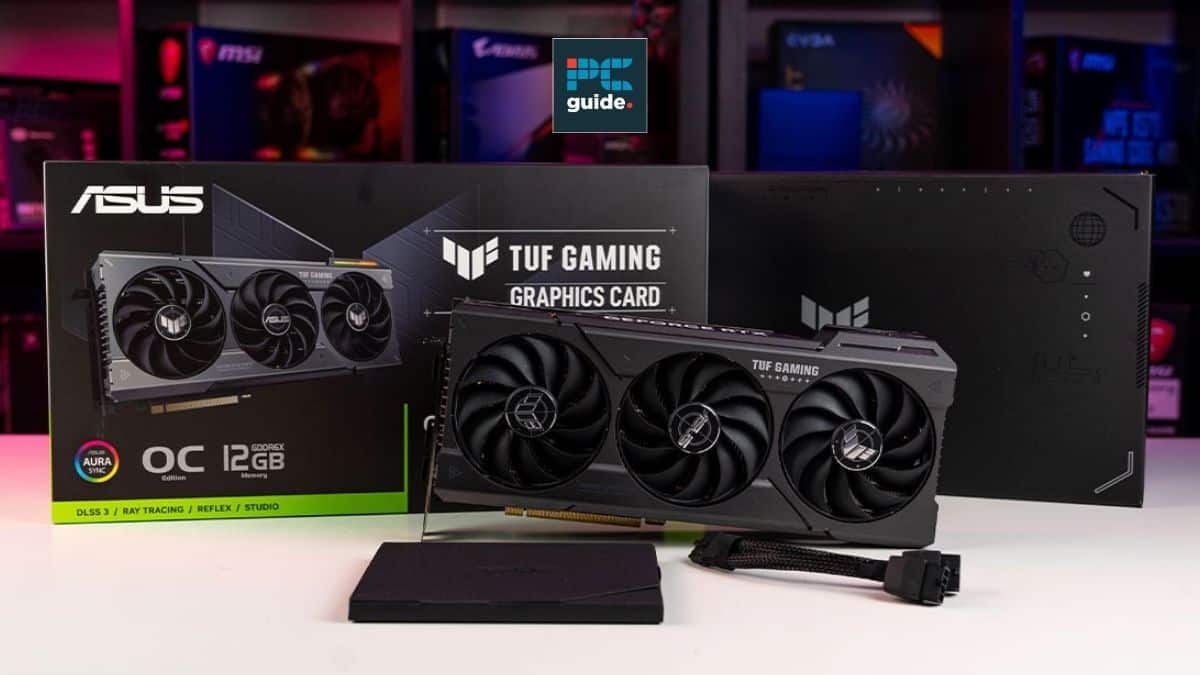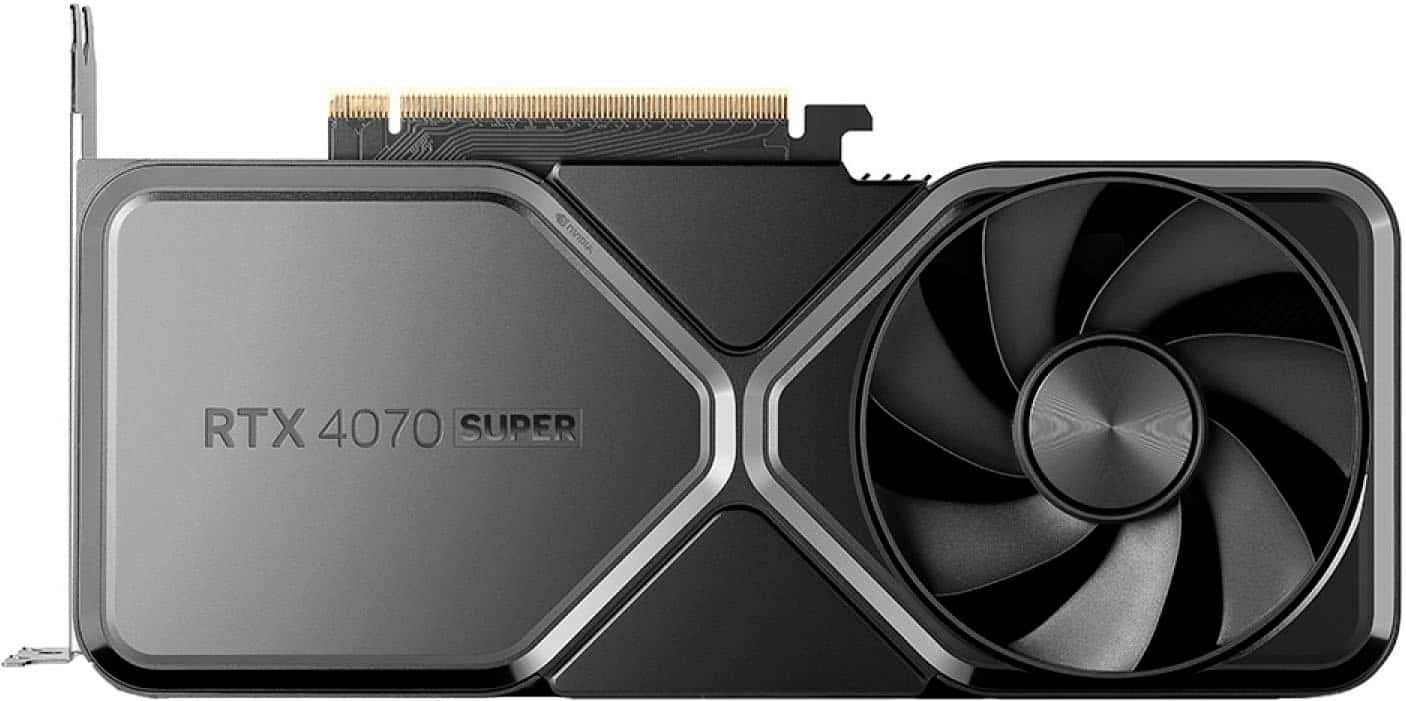RTX 4070 Super vs RX 7700 XT – Power or value?

Table of Contents
Two top-tier yet affordable GPUs have emerged to vie for the attention of gamers and PC enthusiasts alike – the RTX 4070 Super from NVIDIA and the RX 7700 XT from AMD. Both promise cutting-edge performance. As consumers, the crucial decision lies in choosing between the raw power of the RTX 4070 Super and the potentially more budget-friendly RX 7700 XT. This article compares RTX 4070 Super vs RX 7700 XT to help you make an informed decision.
RTX 4070 Super vs. RX 7700 XT: Specs comparison
| Specification | RTX 4070 Super | RX 7700 XT |
|---|---|---|
| Architecture | Ada Lovelace | RDNA 3.0 |
| Process Size | 5 nm | 5 nm |
| Transistors | 35,800 million | 28,100 million |
| Base Clock | 1980 MHz | 1700 MHz |
| Boost Clock | 2475 MHz | 2544 MHz |
| Memory Clock | 1313 MHz (21 Gbps effective) | 2250 MHz (18 Gbps effective) |
| VRAM / Memory Size | 12 GB | 12 GB |
| Memory Bus | 192 bit | 192 bit |
| Bandwidth | 504.2 GB/s | 432.0 GB/s |
| Shading Units | 7168 | 3456 |
| SM/Array Count | 56 | 54 |
| Tensor Cores | 224 | 216 |
| RT Cores | 56 | 54 |
| L1 Cache | 128 KB per SM | 128 KB per Array |
| L2 Cache | 48 MB | 2 MB |
| L3 Cache | NA | 48 MB |
| TDP | 220 W | 245 W |
| Price / MSRP | $599 | $449 |
Architectural foundation
At their core, the RTX 4070 Super and RX 7700 XT differ in architectural design. The RTX 4070 Super is based on NVIDIA’s Ada Lovelace architecture, while the RX 7700 XT is powered by AMD’s RDNA 3.0. Both architectures, crafted on a 5 nm process size, are a testament to modern efficiency in GPU technology.
Prime Day is finally here! Find all the biggest tech and PC deals below.
- Sapphire 11348-03-20G Pulse AMD Radeon™ RX 9070 XT Was $779 Now $739
- AMD Ryzen 7 7800X3D 8-Core, 16-Thread Desktop Processor Was $449 Now $341
- ASUS RTX™ 5060 OC Edition Graphics Card Was $379 Now $339
- LG 77-Inch Class OLED evo AI 4K C5 Series Smart TV Was $3,696 Now $2,796
- Intel® Core™ i7-14700K New Gaming Desktop Was $320.99 Now $274
- Lexar 2TB NM1090 w/HeatSink SSD PCIe Gen5x4 NVMe M.2 Was $281.97 Now $214.98
- Apple Watch Series 10 GPS + Cellular 42mm case Smartwatch Was $499.99 Now $379.99
- ASUS ROG Strix G16 (2025) 16" FHD, RTX 5060 gaming laptop Was $1,499.99 Now $1,274.99
- Apple iPad mini (A17 Pro): Apple Intelligence Was $499.99 Now $379.99
*Prices and savings subject to change. Click through to get the current prices.
Clock speeds – A key performance indicator
Clock speeds play a pivotal role in determining GPU performance. The RTX 4070 Super boasts a base clock of 1980 MHz and a boost clock of 2475 MHz, slightly outperforming the RX 7700 XT, which has a base of 1700 MHz and a boost of 2544 MHz. While this gives the RTX 4070 Super an advantage, clock speeds are only part of the performance equation.
Core counts and memory configurations
Core architecture is where we see more pronounced differences. The RTX 4070 Super leads with 7168 shading units, 56 SM counts, 224 Tensor Cores, and 56 RT Cores. In contrast, the RX 7700 XT offers 3456 shading units, 54 SM counts, 216 Tensor Cores, and 54 RT Cores. These disparities may impact the GPUs’ parallel processing abilities and efficiency in specialized tasks.
Both GPUs come equipped with 12 GB of VRAM, but their memory performance differs. The RTX 4070 Super’s memory clock stands at 1313 MHz with a bandwidth of 504.2 GB/s. The RX 7700 XT, with a memory clock of 2250 MHz, offers a bandwidth of 432.0 GB/s. This means the RTX 4070 Super may have the upper hand in memory-intensive tasks.
Smart access memory and upscaling technologies
Smart Access Memory (SAM) technology in the RX 7700 XT enhances performance by allowing the CPU to fully access the GPU memory. This could be a game-changer for systems with compatible motherboards. Upscaling technologies also play a crucial role. Both NVIDIA and AMD have their unique upscaling solutions to boost game performance and visuals, offering significant enhancements in supported games.
Which GPU for your desktop?
For those building a desktop PC, the choice between these GPUs boils down to specific needs. While the RTX 4070 Super might offer a performance boost in certain areas, the RX 7700 XT, with its SAM compatibility and upscaling technology, could present a more balanced option for many users. The decision hinges on the individual’s performance expectations and compatibility with their existing system.

RTX 4070 Super vs. RX 7700 XT – Performance and benchmarks
When comparing the performance of Nvidia’s RTX 4070 Super and AMD’s RX 7700 XT, the RTX 4070 Super generally takes the lead. This Nvidia graphics card boasts a higher base and boost clock speeds, along with a larger number of shading units, Tensor Cores, and RT Cores. These components are crucial for demanding tasks in modern gaming and rendering applications. Games that heavily leverage shading units and advanced ray tracing will likely benefit from the superior capabilities of the RTX 4070 Super.
Our performance metrics and comparisons here are rooted in our in-house reviews. We have conducted thorough reviews of both the RTX 4070 Super (review) and RX 7700 XT (review) which are available now. Each review features performance tests and benchmark results, some of which are displayed below – further demonstrating the difference between these two GPUs.
The RTX 4070 Super’s higher memory bandwidth is another factor contributing to its enhanced performance. This aspect is particularly significant for memory-intensive tasks such as 3D rendering and high-resolution video editing. The larger cache size in the RTX 4070 Super plays a pivotal role in managing large datasets efficiently, ensuring smoother data processing and quicker access during intensive computational tasks.
On the other hand, the RX 7700 XT from AMD brings its own set of strengths to the table. It features a significantly larger L3 cache, which may offer advantages in workloads that require extensive memory access. This can be particularly beneficial in specific computational scenarios where rapid access to large volumes of data is crucial.
| Game / Title | Nvidia RTX 4070 Super 1080p / 4K | AMD Radeon RX 7700 XT 1080p / 4K |
|---|---|---|
| Assassin's Creed Mirage | 150 FPS / 119 FPS | N/A |
| Avatar: Frontiers of Pandora | 117 FPS / 80 FPS | N/A |
| The Finals | 256 FPS / 73 FPS | N/A |
| Rainbow Six Siege | N/A | 512 FPS / 184 FPS |
| Cyberpunk 2077 | N/A | 122 FPS / 36 FPS |
| Overwatch 2 | N/A | 260 FPS / 171 FPS |
RTX 4070 Super vs. RX 7700 XT- Price
High-end option: RTX 4070 Super
The RTX 4070 Super, with its $599 price tag, caters to the high-end market segment. This GPU is engineered for users who demand the utmost in performance, be it for advanced gaming, intense 3D rendering, or professional-level video editing. Its pricing reflects its superior specifications, making it a prime choice for enthusiasts and professionals seeking top-notch performance.
Budget-friendly alternative: RX 7700 XT
In contrast, the RX 7700 XT presents a more economical option at $449. This $150 saving is substantial for budget-conscious users or those whose needs don’t require the pinnacle of GPU performance. Despite being more affordable, the RX 7700 XT still delivers strong performance across various tasks, striking a balance between cost and capability.
Laptop GPU considerations
The choice between these GPUs becomes more critical in the context of gaming laptops. Laptops featuring the RTX 4070 Super are expected to be pricier but offer superior gaming and multitasking capabilities. On the other hand, laptops with the RX 7700 XT might offer a more affordable alternative for standard gaming and everyday use.
Making the right choice
The decision between the RTX 4070 Super and RX 7700 XT ultimately depends on individual requirements and budget constraints. While the RTX 4070 Super promises enhanced performance, its higher cost may not suit every user.
Conversely, the RX 7700 XT, despite being less powerful, offers considerable savings and still performs commendably, making it a value-driven choice for many users. Prospective buyers should carefully evaluate their specific needs against the performance gains and costs associated with each GPU to make the most informed decision.
Final verdict
If you seek performance, we advise you to go with the better raw power of the RTX 4070 Super. If top-tier performance is non-negotiable and budget constraints are flexible, the RTX 4070 Super is a compelling choice. Its superior specifications, higher clock speeds, and larger core counts make it an ideal candidate for gaming enthusiasts. On the other hand, the RX 7700 XT caters to users who seek a balance between performance and value.


